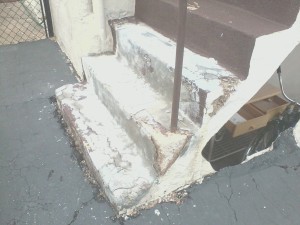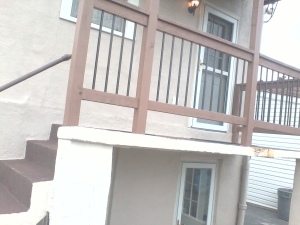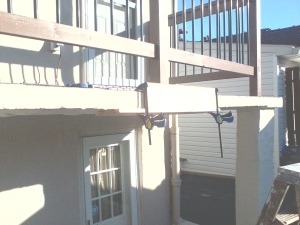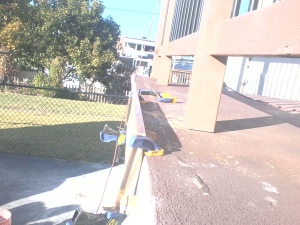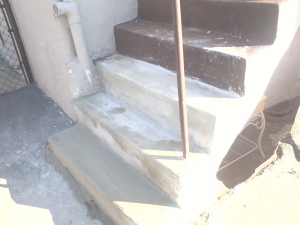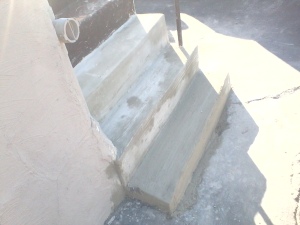Scotts Contracting St.Louis Design Build Sustainable Building Contractor-providing diversified quality service at a fair price. For all of your remodeling, repairs, and maintenance needs.
Search This Blog
11.03.2011
Tracking two important EPA pollution rules
11.02.2011
Green Home Renovation Tips for Fire Safety - Guest Post
Green Home Renovation Tips for Fire Safety-
Guest Post by: Ms Sally DavisonWhen it comes to sustainable home construction and renovation, fire safety should also be a concern. Preventing fires is a green practice in itself, because fires present a serious threat to the environment in terms of emitting toxic smoke and chemicals and creating hazardous debris and waste. Firefighters also have to use a considerable amount of water to fight a fire, and this water can turn into dangerous runoff containing various chemicals.Here are some areas of green home renovation that will make your home fire-resistant.Insulation – Spray-foam insulation uses green products, saves energy, and resists fire. It is made from agriculturally based materials like soy and doesn't emit toxic vapors. It creates a perfect seal with no gaps in the wall, which keeps heat from leaking out and mold from growing. The materials are fire-resistant, and the air-tight seal keeps out oxygen that could feed a fire.Natural Lighting – The use of natural lighting such as skylights and large windows can reduce the need for electric lighting in the day time. This saves energy and reduces the risk of something catching on fire near a hot light bulb.Appliances – Old and poorly-maintained appliances pose a significant fire risk. Appliances that use lots of heat such as stoves, dryers, and microwaves should be in good working order. You may want to consider replacing some of your appliances with Energy Star certified ones, as these will use less energy and pose less of a fire risk.Carpeting – Normal carpet fibers can quickly ignite from just a dropped cigarette or match. However, wool carpeting is flame retardant, difficult to ignite, and has low heat-release properties. It also emits fewer toxins and is a biodegradable, renewable resource.Windows – Windows made with heat-reflective glass can significantly reduce the amount of heat that enters the home, which saves energy. They can also reflect up to 90 percent of the heat from a raging wildfire outside the home.Roofing – Metal roofing made from materials such as aluminum or steel are sustainable and fire-safe. These types of materials are non-combustible and will not support a fire. They will also last a lifetime. Vegetative roof systems, which have a layer of soil and vegetation on the roof, can be fire-resistant if they are watered regularly. However, a roof with dry vegetation will actually increase the fire risk for a home.Landscaping – Just by establishing a fire-safe landscape around your home, you will create a "green belt" to protect you from outside fires like wildfires. Remove all dead trees, shrubs, and plants at least 30 feet around your home. Eliminate low-hanging branches and shrubs growing under trees. Replace highly flammable plants and trees with fire-resistant ones like succulents, hedging roses and honeysuckles, and hardwood trees. Keep your landscape well-watered, especially during the dry season.This article was written by Sally Davison. She owns the site Fire Science Degree [update7/11/2013-Good day to you, My name is Mark, and I'm writing as a representative of FireScienceDegree (dot) com. We recently acquired this domain and will, in the near future, begin editing and updating the content. If you look, the most recent blog post is from September 2011. Before we remove everything, I wanted to email as many of the webmasters and bloggers linking to us as possible. You found this information useful once, so I didn't want you caught with missing resources.] Sally is an experienced EMT and loves to write various articles about health and safety.Guest Post Provided by: Scotts Contracting-St Louis Renewable Energy
CSP Design with Heat Recovery Unit-Designed by Scotts Contracting
- CSP-CAD Diagram designed by Scotty, Scotts Contracting-St Louis Renewable Energy Nov 1, 2011
 |
| Updated Concentrated Solar Power Photovoltaic Design with Added Automatic Heat Recovery Unit for Dual Energy Savings |
Design Features:
- Parabolic Trough Focuses the Suns Rays onto the Receiver
- Photovoltaic Receiver creates Electricity and
- Energy via the Automatic Heat Recovery Unit
- Many of the CSP designs on the Market today "create steam to generate electricity". This design will create electricity efficiently via Photo-voltaic Cells in the receiver; thus eliminating the need for Steam Engines. It also generates heat to be used in the Heat Recovery Unit (twice as much usable energy for today's home and business).
- Heat Recovery Unit incorporates a automatic air handler set by thermostat for transferring climatically controlled air movement.
- This design works exceptionally well during the winter time when the suns radiation is at it lowest radiation level-the loss of energy is minimized by the Heat Recovery Unit.
- Concentrated Solar Power will soon be available for non-desert regions and easily adaptable for any region.
- System allows for the'Receiver' to easily upgrade to new and developing Photovoltaic Cells for increased electrical output
Seeking Assistance to further Develop this CSP Design2. Please use the Contact Form> for additional info and Scotty, Scotts Contracting will reply ASAP.
11.01.2011
Repairing Concrete Steps-Hints-Suggestions-Photos
Repair It-Don’t Replace It-Concrete Steps
Repairing Concrete Steps instead of Replacing-Job Notes, Suggestions, and Hints.
Whether it is downturn of economy or people choosing to save money, many of my clients are choosing to “Repair rather than Replace” the materials used in the construction of their home or business.
If you decide that this type of DIY concrete repair is more than you can handle on your own. Scotts Contracting is available to assist you in your project. Fill in the form (provided below) and Scotty will respond asap to your request.
In the photos you can see:
- How the prior concrete patch job had deteriorated and made the Concrete Steps a Safety Issue for the homeowner.
- Quick and Easy Concrete Form for Repairing Concrete Walkway
- Materials used to Repair / Resurface the Concrete Steps (Home Depot Products)
- Rapid Set Cement – Multi-Purpose Construction Material
- Quikrete 1-Gallon Concrete Bonding Adhesive
- Quikrete 1 qt. Acrylic Fortifier
- Concrete Reinforcing-#4 Rebar- 1/2 in.
- Tools needed to accomplish Concrete Step Repair
- Darby
- Hammer-Drill w/ 1/2 Concrete Bit and Flat Bit
- Concrete Floats and Edgers
- Screw Gun
- Clamps
- Wire Brush
- Buckets
- Broom/Brush
- To increase the life expectancy of this concrete patch and increase the adhesive properties. (A)An acrylic bonding agent was used in the mixture of Concrete and Water. (B) Surface Bonding Agent applied to clean surfaces before patch was installed. The working time for the patch will be under 15 mins. Only mix enough patch to work small areas ( 1/4 of a 5 Gal Bucket at a time )
- When repairing steps if at all possible start at the top step and work down
- Clean Hand Trowels often to remove adhesive from the Acrylic Agent for a smooth finish that can later be worked into the finished texture (Broom Finish or Swirl Finish)
If you decide that this type of DIY concrete repair is more than you can handle on your own. Scotts Contracting is available to assist you in your project. Fill in the form (provided below) and Scotty will respond asap to your request.
Related articles
- How to Repair Water Damaged Stucco – Interior(scottscontracting.wordpress.com)
- Resurfacing Old Cocrete to Look New Again(theconcreteprofessor.com)
- ECO CONSCIOUS, GREEN BUILD TAGGED WITH CONCRETE, CONCRETE REPAIR, CONCRETE STEP REPAIR, CONSTRUCTION AND MAINTENANCE, HINTS, MATERIALS AND SUPPLIES, REBAR, SCOTTS CONTRACTING
If you are interested in Green Building on an Investment Property Check out the Benton Gut Rehab Blog Series-Benton Gut Rehab Green Blog Series
Part 8: 1st Floor Weatherization
Part 9: See the Difference a Little White Paint Makes
Part 10: Interior Framing-Plumbing-Laundry Room
Part 11: Kitchen Framing Tip #36-Benton Rehab Project
Part 12: Water Main Repair- Benton Rehab
Part 13: Benton Rehab Project Drywall Installation and Tip: Number 1172
Green-Sustainable Design-Construction Service for Home and Business- Repair and Improvements for St Louis, Green Products,Insulation, Weatherization, Solar, Home Improvement. My Green Dream is to build a GREEN St Louis find green news at: http://stlouisrenewableenergy.blogspot.com or http://scottscontracting.wordpress.com
10.31.2011
Senate Bill 321 =Nuclear Energy Rate Hike Bill
--
*Scott's Contracting*
Green Me UP-Scotty <http://greenmeupscotty.wordpress.com>
scottscontracting@gmail.com
http://stlouisrenewableenergy.blogspot.com
http://scottscontracting.wordpress.com
http://twitter.com/StLHandyMan
https://www.facebook.com/GreenMeUPScotty
Solar power is beginning to go mainstream – USATODAY.com
Solar power installations doubled in the United States last year and are expected to double again this year. More solar energy is being planned than any other power source, including nuclear, coal, natural gas and wind.
"We are at the beginning of a turning point," says Andrew Beebe, who runs global sales for Suntech Power, a manufacturer of solar panels.
Solar's share of the power business remains tiny. But its promise is great. The sun splashes more clean energy on the planet in one hour than humans use in a year, and daytime is when power is needed most. And solar panels can be installed near where people use power, reducing or eliminating the costs of moving power through a grid.
10.29.2011
Fire Proof-Air Tight-Electrical Junction Box Cover
Air Sealing a Ceiling Electrical Junction Box
Sealing Air Leaks
Warm air leaking into your home during the summer and out of your home during the winter and can waste a lot of your energy dollars. One of the quickest dollar-saving tasks you can do is caulk, seal, and weatherstrip all seams, cracks, and openings to the outside.
You can save on your heating and cooling bill by reducing the air leaks in your home.
Hint: Use Fire Rated: 5/8″Fire Rated Drywall or Sheetrock with Fire Proof Caulking to
Create the Air Tight Seal
Tips for Sealing Air Leaks
Air infiltrates into and out of your home through every hole and crack. About one-third of this air infiltrates through openings in your ceilings, walls, and floors.
- First, test your home for air tightness. On a windy day, carefully hold a lit incense stick or a smoke pen next to your windows, doors, electrical boxes, plumbing fixtures, electrical outlets, ceiling fixtures, attic hatches, and other locations where there is a possible air path to the outside. If the smoke stream travels horizontally, you have located an air leak that may need caulking, sealing, or weatherstripping.
- Caulk and weatherstrip doors and windows that leak air.
- Caulk and seal air leaks where plumbing, ducting, or electrical wiring penetrates through walls, floors, ceilings, and soffits over cabinets.
- Install foam gaskets behind outlet and switch plates on walls.
- Look for dirty spots in your insulation, which often indicate holes where air leaks into and out of your house. You can seal the holes with low-expansion spray foam made for this purpose.
- Look for dirty spots on your ceiling paint and carpet, which may indicate air leaks at interior wall/ceiling joints and wall/floor joists. These joints can be caulked.
- Install storm windows over single-pane windows or replace them with more efficient windows, such as double-pane. See Windows on page 18 for more information.
- When the fireplace is not in use, keep the flue damper tightly closed. A chimney is designed specifically for smoke to escape, so until you close it, warm air escapes—24 hours a day!
- For new construction, reduce exterior wall leaks by installing house wrap, taping the joints of exterior sheathing, and comprehensively caulking and sealing the exterior walls.
- Use foam sealant around larger gaps around windows, baseboards, and other places where warm air may be leaking out.
- Kitchen exhaust fan covers can keep air from leaking in when the exhaust fan is not in use. The covers typically attach via magnets for ease of replacement.
- Replacing existing door bottoms and thresholds with ones that have pliable sealing gaskets is a great way to eliminate conditioned air leaking out from underneath the doors.
- Fireplace flues are made from metal, and over time repeated heating and cooling can cause the metal to warp or break, creating a channel for hot or cold air loss. Inflatable chimney balloons are designed to fit beneath your fireplace flue during periods of non-use. They are made from several layers of durable plastic and can be removed easily and reused hundreds of times. Should you forget to remove the balloon before making a fire, the balloon will automatically deflate within seconds of coming into contact with heat.
Areas that leak air into and out of your home cost you lots of money. Check the areas listed below.
|
|
|
St Louis Renewable Feed
-
Thank You for stopping by the Green Blog. If additional information in needed or you have a question let me know by posting a question or ...
-
Making a decorative axe from melted copper wire by u/SinjiOnO in oddlysatisfying Thank You for stopping by the Gree...

